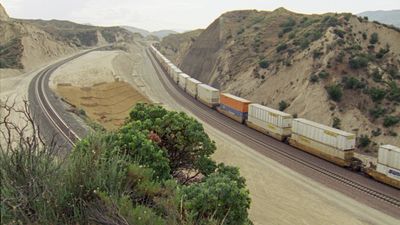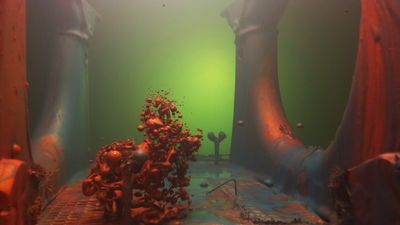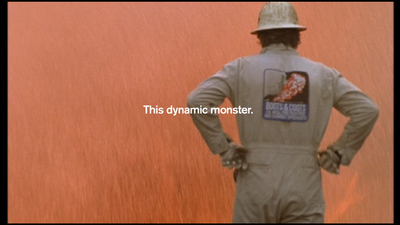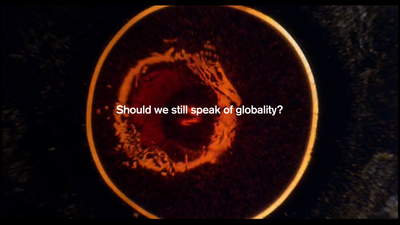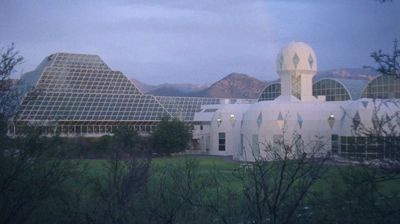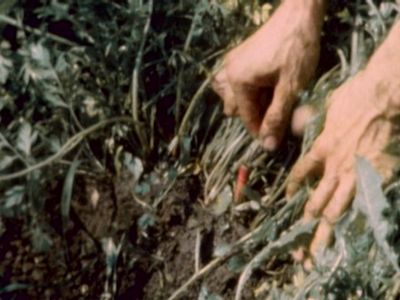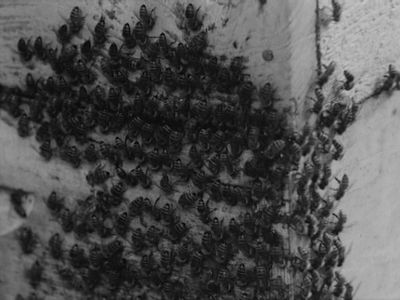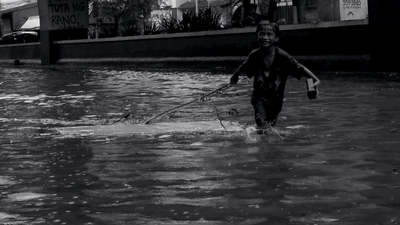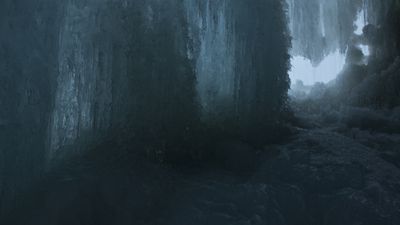Film programme: Host
Céline Condorelli’s installation Host consists of a large-scale curtain installation and a film programme in seven parts – Abstractions, Land, Water, Enclosures, Distance, Sea and Seed – each on view for twelve days. The programme combines documentaries, artists’ films and feature-length films dealing in some way with the consequences of living in a dangerously warmer world for people, animals and landscapes.
1 Abstractions
26.01.–31.01.2020
(Previous screenings: 26.04.–05.05.2019 / 14.05.-19.05.2019)
Ilha das Flores, Jorge Furtado (1989)
35 mm | 12:31 min.
The island of flowers (Ilha das Flores) is a place where some people eat the leftovers of pigs’ dinners, after seemingly everyone else has eaten too. This film follows a tomato that ends up being the dinner of poor women and children, via the myriad turns and loops its life went through since it left Mr Suzuki, who grew it. This seemingly meaningless life-cycle of waste is accompanied by a deluge of relentless descriptions of the chain of events that led it to be; and this of course fails to justify the unfairness of consumer society, but on the contrary only highlights how absurd is.
Coal Money, Wang Bing (2009)
53 min.
’Coal money’ is what the drivers of 100-ton trucks are following endlessly, to and fro, day and night, on the road linking the Shanxi mines with the port of Tianjin in northern China. China is hungry for coal, but coal is heavy, dirty, filled with dust, rocks and sand. Along the route the drivers encounter prostitutes, cops, petty racketeers, garage owners, mechanics, haggling and blackmail, everyone trying to cheat everyone else, according to the harsh reality of street capitalism. As the coal moves between different buyers and sellers, Wang patiently observes the endless human attempts to extract a profit at whatever cost.
Urth, Ben Rivers (2016)
16mm & Super 8 transferred to HD, 19 min.
Filmed in Arizona’s Biosphere 2, Urth records a nameless scientist’s monologue describing her final days inside an experimental ecosystem. She might be the last woman on earth, or the last scientist attempting life in a separate, closed and yet sustainable world. The film offers a meditation on the possibility for life in human-made environments, and the impossibilities of life in human-damaged ones. As in many of Rivers films, utopias are lived experiences, rooted in real people and situations, here through the efforts to support and maintain human life as an ongoing relationship between life systems. The film takes its title from an Old Norse word suggesting the twisted threads of fate (as cited by Timothy Morton in his recent book, Dark Ecology).
Inhabitants, Artavazd Pelechian (1970)
35 mm. transferred to digital video, 9 min.
For the most part, Inhabitants depicts animals in panic. The film is filled with shots of large-scale migrations and stampedes (with, surprisingly, some helicopter shots), but merely alludes to the presence of human beings—a few silhouettes who seem to be the cause of these vast anxious movements of animal fear. In many ways this film is an ode to the animal world, through a movement towards formal abstraction, with clouds of silver birds pulverising light. They are the inhabitants of the earth. Pelechian said that “it’s hard to give a verbal synopsis of these films. Such films exist only on the screen, you have to see them”.
Total duration: 95 min.
2 Land
01.02.–05.02.2020
(Previous screenings: 21.05.–02.06.2019)
The Jealous One, Karrabing Film Collective (2017)
Digital video, 29 min.
Emphasising the shifting of identity and social confusion brought about by postcolonialism, the Karrabing Film Collective’s The Jealous One unfolds along two plot lines that meet in a dramatic final encounter. The first, a story of an Indigenous man weaving through bureaucratic red tape to get to a mortuary service on his ancestral land; and the second, a fight between a husband consumed by jealousy and his wife’s brother, who excludes him from community ceremonies. The Jealous One, like most of the Karrabing Film Collective’s films, uses a fresh and often playful approach to evoking the multiple traditions forming daily life in the Indigenous communities in Australia’s Northern Territory.
First Mark, Peter Nadin, Natsuko Uchino & Aimée Toledano (2008)
Super 8 & 16 mm film transferred to video, 9 min.
“A carrot is not a work of art. I’m not proposing that anyone think of a carrot as a work of art. But what I am saying is that a carrot and the art I make here are both results of the same process.” First Mark is a poetic, immersive observation of artist Peter Nadin’s Old Field Farm in Cornwallville, NY, which he co-runs with his partner. Both a diary and a poetic reverie, articulated around the artist’s own narrating voice, the film opens the doors to the farm’s activities in which art and agriculture come together. Nadin’s thoughts and visions unfold during the combined documentation of the farm’s labour activities – chicken feeding, bee-hiving, pig breeding – and his moments of artistic production.
Forest Law, Ursula Biemann and Paulo Tavares (2014)
Two-channel video installation transferred to one-channel video, 32 min.
Forest Law is the outcome of a research project about the oil-and-mining frontiers in the Ecuadorian Amazon rain forest, and follows Brazilian architect Paulo Tavares on a field trip in 2013. One of the most biodiverse and mineral-rich regions on Earth, the Amazonian rain forest is also the site of a monumental struggle between the impending threat of large-scale extractions, and what is being defined as the Rights of Nature. A series of landmark legal cases have brought the forest to court, and these are encountered through the people taking them on, such as the Kichwa Indigenous People of Sarayuku, who have won a case based on their cosmology of the Living Forest.
Megara, Saki Maniatis & Yorgos Tsemberopoulos (1973/1974)
Colour & B/W, 35 mm transferred to video, 69 min.
Megara is about the fight of a Greek village against the confiscation of farmland by the state and its clearing by a private investor. The year is 1973. The trigger for the villagers' outrage is the destruction of an ancient olive orchard; a revolt that soon developed into the first mass protests against the military junta. Initially attracted by the horrible images of the destroyed olive orchard, directors Maniatis and Tsemberopoulos soon realized that what was happening in Megara was not only another case of the fascist state showing its colours but that the farmers’ protests and actions could spark a larger mobilization against the regime. The film focuses on the gradual development of the events, on the forms of dialogue through which the villagers come to grips with what is at stake for them and what resistance means under the circumstances.
Inhabitants, Artavazd Pelechian (1970)
35 mm. transferred to digital video, 9 min.
For the most part, Inhabitants depicts animals in panic. The film is filled with shots of large-scale migrations and stampedes but merely alludes to the presence of human beings – a few silhouettes who seem to be the cause of these vast anxious movements of animal fear. In many ways, this film is an ode to the animal world, through a movement towards formal abstraction, with clouds of silver birds pulverising light. They are the inhabitants of the earth. Pelechian said that “it's hard to give a verbal synopsis of these films. Such films exist only on the screen, you have to see them”.
Total duration: 150 min.
3 Water
06.02–09.02.2020
(Previous screenings: 04.06.–16.06.2019)
Storm Children: Book One, Lav Diaz (2014)
143 min.
In 2013, the Philippines was devastated by what is considered the strongest storm in history, the Typhoon Haiyan. Shot in the aftermath of the storm, Lav Diaz’s documentary is composed of a number of shots following children playing or merely surviving in the rubble. It is unclear whether the children are alone or whether there is someone taking care of them. Deprivation in an almost apocalyptic world emerges out of their make-do society, filtered through rain. It rains incessantly – water is ever present, both in the foreground and background, in the sky, on the ground. The ground becomes water. Lav Diaz said, “Resilience. We are the storm people. The storm could be the Filipino’s original Anito (God); we had so many gods before Christ and Allah came to our endless shores. On average, the Philippines are now battered by 28 storms every year, but that doesn’t make us a storm-battered race. In fact, we’ve become this storm-loving people. The storm is very much a part of our reality. Double that average, the Filipino can still take it.”
Inhabitants, Artavazd Pelechian (1970)
35 mm. transferred to digital video, 9 min.
For the most part, Inhabitants depicts animals in panic. The film is filled with shots of large-scale migrations and stampedes, but merely alludes to the presence of human beings – a few silhouettes who seem to be the cause of these vast anxious movements of animal fear. In many ways this film is an ode to the animal world, through a movement towards formal abstraction, with clouds of silver birds pulverising light. They are the inhabitants of the earth. Pelechian said that “it's hard to give a verbal synopsis of these films. Such films exist only on the screen, you have to see them”.
Total duration: 152 min.
4 Enclosures
11.02.–15.02.2020
(Previous screenings: 18.06.–30.06.2019)
Song for Earth and Folk, Cauleen Smith, sound by The Eternals (2013)
16mm & Super 8 transferred to digital video, 10:40 min.
Song for Earth and Folk is made out of found footage from Chicago Film Archives and is structured like a blues song with a live-improvised electro-organic soundtrack created by Chicago-based band The Eternals. Cauleen Smith describes the film as follows: “A lament – a blues song about a woman who has been done wrong – seemed a wholly appropriate way to explore this fated relationship between Earth and Folk. Late-stage capitalism depends on destroying everything, so that profits can be extorted out of the process of repair and restoration (wars in Afghanistan, Syria, DRC, Liberia). As we speak, the planet responds. She’s gearing up for hurricane season; She’s got two volcanoes on full blast. She refuses to drop water on the west coast of North America, She is raising water table levels, sinking grand old cities, and tiny little islands. Our spaceship is doing what She must. I wish we humans would do the same.”
Unearthing Disaster I, Angela Anderson & Angela Melitopoulos (2013)
HD-video, 36 min.
In 2013, Angela Anderson and Angela Melitopoulos began documenting the environmental, social and psychological consequences of the construction of a massive open pit gold mine by Canadian mining company Eldorado Gold in the region of Halkidiki in North-eastern Greece. Unearthing Disaster I accompanies local activists on a journey through their once-familiar landscape, which in a matter of days was transformed beyond recognition. Through the course of this journey, the scale of the imminent disaster unfolds: millions of trees are cut down and clean water disappears. A social movement formed to prevent the destruction of this ancient landscape is violently repressed by police and private security. Unearthing Disaster I captures the literal pulverisation of a natural and cultural environment and its social form of expression at a time when Greece is forced to implement economic austerity measures.
Serpent Rain, Arjuna Neuman & Denise Ferreira da Silva (2016)
Digital video, 27 min.
An oil refinery, a frozen waterfall, a forest, a Turner painting, a slave ship and an underwater seaweed jungle – these are some of the images that director Arjuna Neuman and philosopher Denise Ferreira da Silva compile in their video essay Serpent Rain. Through the fragmented montage of scenarios, Neumann and da Silva try to represent a non-linear perception of time and to rethink the link between memory and time. Crossing four waters: the Mediterranean, the Pacific, the Atlantic and the Indian Ocean, we follow the displacement of peoples alongside the movement of clouds, ideas, earth, and migration of matter, at a quantum level, from one state to another. Taking a planetary view of the world as a single mass, the human and the non-human are part of each other, joined through water, the life source, in flux and flowing.
What is Deep Sea Mining? Episode 1: Tools for Ocean Literacy (2018), Pedro Neves Marques and Mariana Silva with Margarida Mendes.
Digital video, 6:44 min.
What is Deep Sea Mining? is a 5-episode web series dedicated to the topic of deep-sea mining, a new frontier of resource extraction at the bottom of the ocean. The first episode is structured around a single shot along a vertical axis. Through the technologies that have contributed to our (very partial) knowledge of the deep sea, the episode uncovers what is at stake in this new type of resource extraction. As mining companies are starting to lease areas in national and international waters, potential impacts on ecosystems are yet to be assessed by the scientific community, and local communities are not being consulted. After all, we know less about the ocean depths than about the universe beyond this blue planet.
¿Has Visto? Colectivo Los Ingrávidos (2017)
16 mm transferred to HD-video, 9:46 min.
Every year on May 10, the Mexican Mothers March takes place in a number of Mexican cities where mothers take a stand against the disappearance of thousands of civilians in Mexico every year. ¿Has Visto? (Have You Seen?) by Colectivo Los Ingrávidos uses footage from these protests. Made from the perspective of the mothers, the film is part of a trilogy about gendered violence against women in Mexico. As with the other films in the trilogy, ¿Has Visto? is made with expired film stock, which produces the characteristic pinkish tone, the washed-out colours and the antiquated look. In this subtle manner, Colectivo Los Ingrávidos would seem to suggest that the protest – and not least what occasions it – ought to be in the past. That is, however, not the case.
Inhabitants, Artavazd Pelechian (1970)
35 mm. transferred to digital video, 9 min.
For the most part, Inhabitants depicts animals in panic. The film is filled with shots of large-scale migrations and stampedes, but merely alludes to the presence of human beings – a few silhouettes who seem to be the cause of these vast anxious movements of animal fear. In many ways this film is an ode to the animal world, through a movement towards formal abstraction, with clouds of silver birds pulverising light. They are the inhabitants of the earth. Pelechian said that “it's hard to give a verbal synopsis of these films. Such films exist only on the screen, you have to see them”.
Total duration: 100 min.
5 Distance
16.02.–20.02.2020
(Previous screenings: 02.07.–14.07.19)
Coyolxauhqui, Colectivo Los Ingrávidos (2017)
16mm transferred to HD video, 9:46 min.
In Coyolxauhqui, the camera meanders to the hectic rhythm of an improvised percussion ensemble, capturing blurred snapshots of colourful cactuses and vast landscapes. Halfway through the film, an eerie zoom of the rising moon with a soundtrack of ghostly female voices alludes to the violent murder of the Aztec moon goddess, Coyolxauhqui, by her own brother, Huitzilopochtli. The final minutes of the film refer directly to contemporary Mexican femicides – gender-based murders of women – by showing images of sandals scattered around the ground, a pad over a patch of dry branches, underpants creased between stones, and bras hanging from the dry branches of a bush. Exploring the connection between current Mexican femicides and larger cultural formations, Coyolxauhqui is part of a trilogy that proposes itself as an act of political resistance.
The Forgotten Space, Allan Sekula and Noël Burch (2010)
112 min.
The Forgotten Space follows cargo aboard containerships, barges, trains and trucks. We listen to workers, engineers, planners, politicians, and those marginalized by the global transport system. We visit displaced farmers and villagers in Holland and Belgium, underpaid truck drivers in Los Angeles, seafarers aboard mega-ships shuttling between Asia and Europe, and factory workers in China, whose low wages are the fragile key to the whole puzzle. An essayistic, visual documentary about one of the most important processes that affects us today, the subject of the film, Sekula writes, is “globalization and the sea, the ‘forgotten space’ of our modernity.”
Inhabitants, Artavazd Pelechian (1970)
35 mm. transferred to digital video, 9 min.
Compiling footage of large-scale migrations and stampedes, Inhabitants, for the most part, depicts animals in panic. The film merely alludes to the presence of human beings, who, however, seem to be the cause of these vast anxious movements of animal fear. In many ways, the film is an ode to the animal world through a movement towards formal abstraction with clouds of silver birds pulverising the light. The animals are the inhabitants of the earth. Pelechian says, “it's hard to give a verbal synopsis of these films. Such films exist only on the screen, you have to see them”.
Total duration: 135 min.
6 Sea
21.02.–26.02.2020
(Previous screenings: 16.07.–28.07.19)
Lu Tempu di li pisci spata, Vittorio De Seta (1954)
35 mm transferred to DVD, 11 min.
The time of the swordfish (Lu Tempu di li pisci spata) has since time immemorial taken place between June and August, when the swordfish is hunted in the Strait of Messina in Sicily. The film depicts the work of Sicilian fishermen as they wait, row, call, chase, and sing in a dramatic dance with the fish. The film captures rituals and gestures performed collectively by generations across centuries to the rhythm of voices and incantations. De Seta relentlessly tried to capture labour as the measure of humans’ relations to the natural environment in a world rapidly disappearing before the advance of consumerist globalisation.
Leviathan, Lucien Castaign Taylor and Verena Paravel (2012)
HD, 87 min.
Shot on handheld cameras attached to the filmmakers, crew, and infrastructures alike, Leviathan is set onboard a groundfish trawler navigating the coast of New Bedford, the largest fishing hub of the USA. Sailors, fish, birds, waves, but also cables and metal structures are engaged in a constant struggle between life and death, resource and consumption, individuality and collectivity. A film beyond verbal language, Leviathan features no dialogue: the only human voices heard are sporadic, disembodied cries amid the constant roars of the sea and the vessel’s engine. Dark and majestic, Leviathan offers an unsettling and crude depiction of modern industrial fishery.
Pfui – Pish, Pshaw / Prr, Saskia Olde Wolbers (2017)
HD, 20 min.
Pfui – Pish, Pshaw / Prr is based on interviews with the longest-serving employee of Polyeco/EPE, a Greek oil spill response company. Stationed at the site of the Sea Diamond, a sunken cruise ship off the coast of Santorini for the last ten years, Mr. Theodosis has become the ship’s conscientious guardian, tending to the slow release of petrol and oil to protect the surrounding waters and marine life. The film is composed of archival camcorder footage recorded by Mr. Theodosis and animations of cruise ship interiors, magnetic mussels and molecular structures covered in iridescently coloured dripping oils. Based on a fictional script from an oil spill responder’s point of view, the film combines musings around matter and spirit and ancient rituals for cleansing the sea with Mr. Theodosis’ love for shipwrecks and the mundane everyday reality of cleaning.
Inhabitants, Artavazd Pelechian (1970)
35 mm. transferred to digital video, 9 min.
Compiling footage of large-scale migrations and stampedes, Inhabitants, for the most part, depicts animals in panic. The film merely alludes to the presence of human beings, who, however, seem to be the cause of these vast anxious movements of animal fear. In many ways, the film is an ode to the animal world through a movement towards formal abstraction with clouds of silver birds pulverising the light. The animals are the inhabitants of the earth. Pelechian says, “it's hard to give a verbal synopsis of these films. Such films exist only on the screen, you have to see them”.
Total duration: 125 min.
7 Seed
27.02.–01.03.2020
(Previous screenings: 30.07.–11.08.19)
A Film, Reclaimed, Ana Vaz and Tristan Bera (2015)
HD video, 19 min.
A Film, Reclaimed is the result of a research-based project on the Anthropocene and the ecological crisis involving, among others, the French philosopher Bruno Latour. The project took place as a “debate theatre”, a symposium, which formally simulated the upcoming climate talks in Paris during COP21. The text-based film is a collage of quotes from the participants' conversations and reflections during the interdisciplinary meetings, attended by artists, philosophers, politicians, lawyers and others. An underlying idea of the film is that the film medium and the acceleration of the modern condition – now recognised as the Anthropocene – has developed in parallel and shares a common history.
Wild Relatives, Jumana Manna (2018)
HD video, 66 min.
Deep in the earth beneath the Arctic permafrost, seeds from all over the world are stored in the Svalbard Global Seed Vault, to provide a backup should disaster strike. In 2012, an international agricultural research centre was forced to relocate from Aleppo in Syria to Lebanon due to the Syrian civil war, and began the laborious process of re-planting their seed collection from the Svalbard back-ups. Wild Relatives follows the path of this seed transaction between the Arctic and Lebanon, through a series of encounters that unfold the matrix of human and non-human conditions across two distant realities of the planet. Through its meditative, intimate pace, the film teases out tensions between state and individual, industrial and organic approaches to seed saving, climate change and biodiversity, witnessed through the journey of the seeds.
Seasons of the Year, Artavazd Pelechian (1975)
35 mm. transferred to digital video, 29 min.
In Artavazd Pelechian’s Seasons of the Year, shepherds of the Armenian highlands struggle through the different annual seasons. Their labour is portrayed at a relentless pace of images hurling and expanding, evolving into a dynamic rhythm of quasi-abstraction. For the first time in Pelechian’s oeuvre, the film does not use any archival material; instead, footage of this isolated farming community is stretched and distorted, cut up and scored to Vivaldi's Four Seasons concert. Pelechian, who usually refrains from describing his work has reluctantly stated, “This film is about everything, not only about the seasons of the year or people, it is about everything”.
Inhabitants, Artavazd Pelechian (1970)
35 mm. transferred to digital video, 9 min.
Compiling archival footage of large-scale migrations and stampedes, Inhabitants, for the most part, depicts animals in panic. The film merely alludes to the presence of human beings, who, however, seem to be the cause of these vast anxious movements of animal fear. In many ways, the film is an ode to the animal world through a movement towards formal abstraction with clouds of silver birds pulverising the light. The animals are the inhabitants of the earth. Pelechian says, “it's hard to give a verbal synopsis of these films. Such films exist only on the screen, you have to see them”.
Total duration: 122 min.
A previous iteration of this project took place in the garden of the Agricultural University of Athens as the outdoor Cinema Zagara, commissioned by Locus Athens for Geometries, and produced with AREA architects in 2018. It hosted the film programme Ecodrome, co-programmed with Filipa Ramos, which has been expanded for Kunsthal Aarhus.
Supported by







